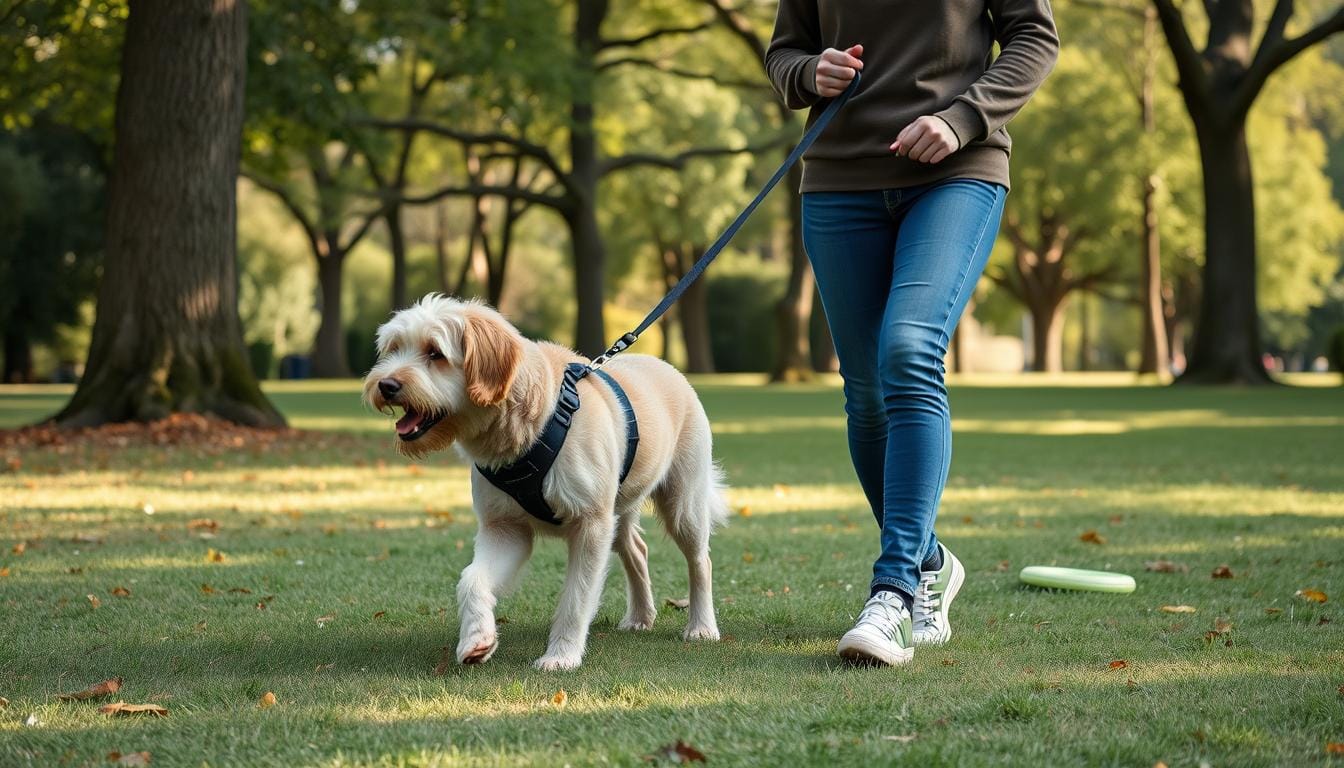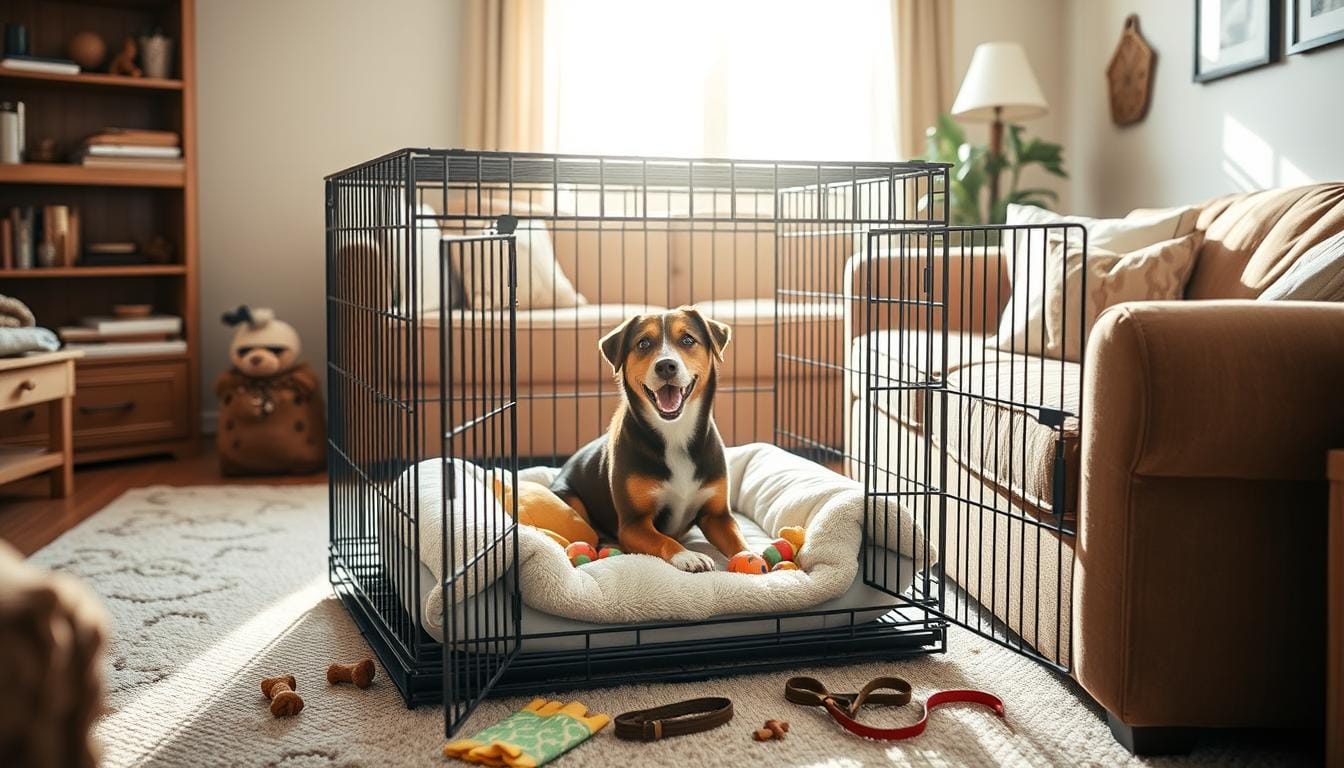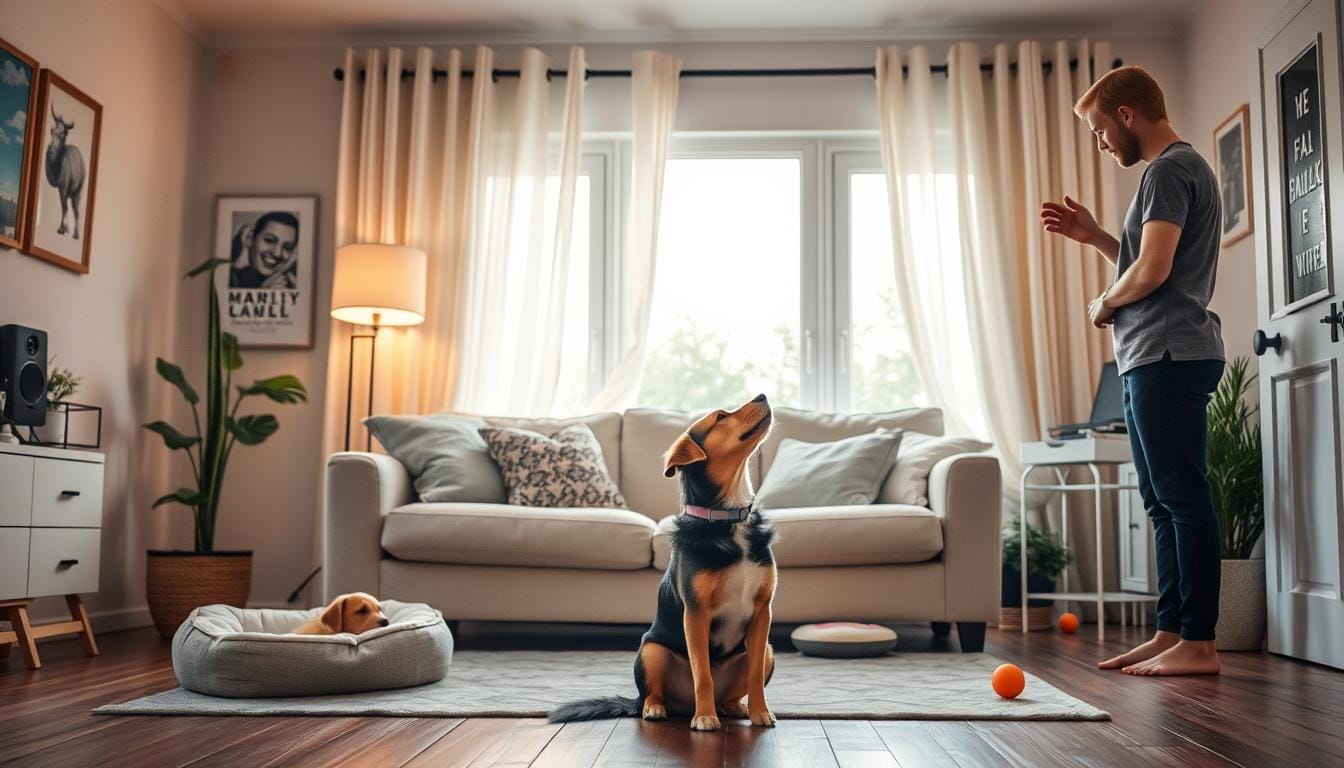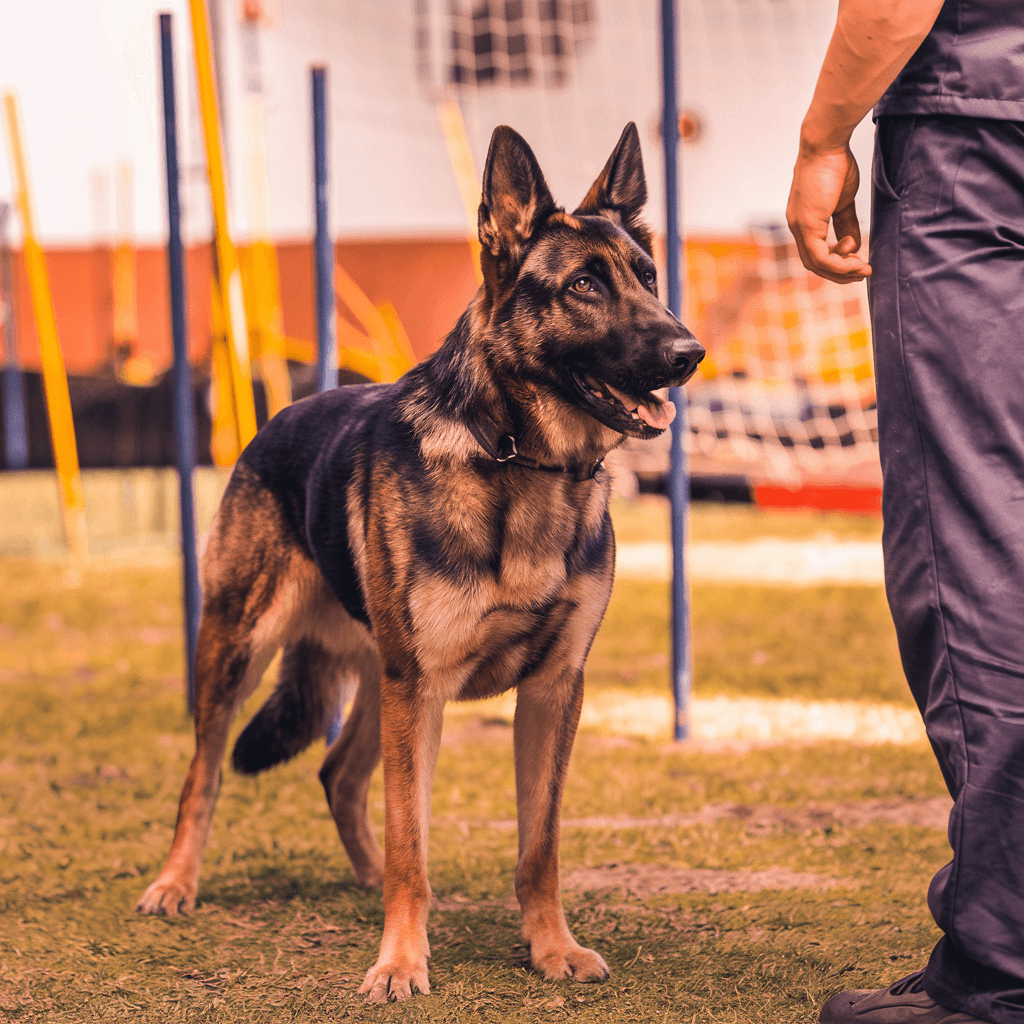Spaying and neutering are key parts of being a responsible pet owner. They do more than just stop unwanted litters. They also boost your dog’s health and care.
Spaying or neutering can make your dog live longer and healthier. The ASPCA says these surgeries cut down on animal aggression. They also stop mating instincts.
For female dogs, spaying stops breast cancer and prevents uterine infections and cancer. Male dogs get benefits too. Neutering lowers testicular cancer and prostate problems risks.
These procedures do more than help your pet. They help control pet numbers and cut down on shelter animals. This makes our communities better for both people and pets.
Key Takeaways
- Spaying/neutering improves overall dog health and behavior
- These procedures reduce cancer risks in both male and female dogs
- They help control pet populations and reduce shelter overcrowding
- The surgeries can be performed as early as eight weeks old
- Costs vary but are a worthwhile investment in your pet’s long-term health
Understanding Spaying/Neutering, Dog Health, Pet Care, Responsible Pet Ownership
Spaying and neutering are key veterinary services. They help with animal welfare and controlling pet numbers. These surgeries remove reproductive organs in dogs. It’s important for pet owners to know how these surgeries benefit their dogs and the community.
Spaying and neutering have many benefits for dogs. They can lower the risk of certain cancers and prevent uterine infections in females. For males, it can reduce aggression, roaming, and marking territory.
“Spaying reduces the risk of breast tumors in dogs by about 50% and by 90% in cats.”
Being a responsible pet owner means more than just caring for your pet. Spaying or neutering helps improve animal welfare and controls pet numbers. It also helps reduce stray animals and eases the load on shelters.
| Benefit | Spayed/Neutered Pets | Unaltered Pets |
|---|---|---|
| Cancer Risk | Reduced | Higher |
| Behavioral Issues | Fewer | More likely |
| Contribution to Overpopulation | None | Significant |
We suggest talking to your vet about when to spay or neuter your pet. Making informed choices about these surgeries can improve your pet’s health. It also helps keep pet numbers in balance in our communities.
Health Benefits of Reproductive Surgery
Reproductive surgery is great for our furry friends. It helps them stay healthy and is key to caring for pets.
Reduced Cancer Risks
Spaying and neutering can lower cancer risks in dogs. Female dogs have less chance of mammary tumors if spayed. Male dogs avoid testicular cancer and prostate issues if neutered.
Prevention of Reproductive Diseases
These surgeries stop many reproductive diseases. Spayed females avoid deadly uterine infections. Neutered males have less chance of prostate problems. Choosing these vet services keeps our pets safe from health issues.
Increased Life Expectancy
Dogs who get reproductive surgery live longer and healthier. They avoid diseases and cancers related to their reproductive organs. This is a big part of caring for pets over the long term.

| Procedure | Benefits | Best Age |
|---|---|---|
| Spaying (Females) | Prevents uterine infections, reduces breast cancer risk | 6-9 months |
| Neutering (Males) | Eliminates testicular cancer, reduces prostate issues | 6-9 months |
Choosing reproductive surgery is a smart choice for our pets’ health. These surgeries, done by skilled vets, are essential for pet care. They prevent health problems and help our dogs live longer, happier lives.
Behavioral Improvements After Surgery
Spaying and neutering pets can make a big difference in their behavior. These procedures help pets become calmer and more loving. This change makes the bond between pets and their families stronger, improving animal welfare.
Neutered male dogs are less likely to wander or mark territory. This makes pet care simpler and home life more peaceful. Spayed females no longer go into heat, which stops restlessness and disrupts routines.
Here are some specific changes we see after these surgeries:
| Behavior | Before Surgery | After Surgery |
|---|---|---|
| Roaming | Frequent attempts to escape | Decreased wandering tendencies |
| Aggression | Higher likelihood of fights | Reduced aggressive behaviors |
| Marking | Frequent urine spraying | Significantly less marking |
| Heat Cycles | Restlessness and attraction of males | Elimination of heat-related behaviors |
These changes make our pets easier to train and more fun to be around. By spaying or neutering, we’re not just being responsible pet owners. We’re also improving our pets’ lives and deepening our connection with them.
Population Control and Community Impact
Spaying and neutering dogs are key to controlling pet populations and improving animal welfare. We’ve seen how these actions positively affect communities all over the United States.
Reducing Shelter Overcrowding
Every year, millions of cats and dogs face euthanasia because of overcrowded shelters. Spaying or neutering our pets can greatly reduce this number. It’s part of being a responsible pet owner, preventing unwanted litters and keeping shelters from getting too full.
Community Cost Savings
Pet overpopulation costs taxpayers and private groups millions of dollars each year. Spaying and neutering pets can cut down on strays, easing the financial load on animal control and shelters. This lets communities use their resources better.

Prevention of Stray Animals
Sterilized pets are less likely to wander off, which means fewer accidents, diseases, and fights. This makes neighborhoods safer and improves public health. By stopping stray animals, we protect our pets and local wildlife too.
| Impact Area | Benefits of Spaying/Neutering |
|---|---|
| Shelter Statistics | Reduced euthanasia rates, decreased overcrowding |
| Community Finances | Lower animal control costs, reduced public health expenses |
| Public Safety | Fewer stray animals, decreased risk of dog bites |
| Pet Health | Longer lifespans, reduced risk of certain cancers |
By choosing to spay and neuter, we make a big difference in our communities. These actions are crucial for being a responsible pet owner. They help keep our pets and society healthy and happy.
Optimal Timing for the Procedure
Choosing the right time to spay or neuter your dog is key for their health. We’ll look at what affects this important decision in pet care.
Age Considerations
The best age for spaying or neutering depends on your dog’s size. Small dogs can get the procedure at 5-6 months. But, bigger dogs might need to wait until they’re almost fully grown. This ensures they grow and develop properly.
Breed-Specific Timing
Research shows breed is a big factor in when to do the surgery. Big breeds like Golden Retrievers and German Shepherds might face joint problems if neutered too soon. It’s best to wait until they’re at least 12 months old.
Pre-Surgery Health Requirements
Before the surgery, your dog needs a full health check. This makes sure they’re ready for surgery and lowers risks. Overweight dogs need more anesthesia and could face more complications, showing why keeping your dog healthy is crucial.
| Dog Size | Recommended Spay/Neuter Age | Special Considerations |
|---|---|---|
| Small (under 22 lbs) | 5-6 months | Before first heat cycle |
| Medium (25-45 lbs) | 6 months | Before first heat cycle |
| Large (over 45 lbs) | 9-15 months | After growth stops |
| Giant (over 75 lbs) | 12-18 months | After growth stops |
Keep in mind, these are just general guidelines. Your vet can give advice tailored to your dog’s needs. This ensures the best health and longevity for your pet.
The Surgical Process Explained
We offer veterinary services for spaying and neutering dogs. These are key for their health and care. Spaying removes a female dog’s uterus and ovaries through an incision. Neutering removes a male dog’s testes near the scrotum.
Both surgeries are done under general anesthesia for your pet’s comfort. The time needed varies by dog size, from 20 to 90 minutes. Most dogs go home the same day, thanks to modern surgery and pain control.
| Procedure | Duration | Recovery Time | Benefits |
|---|---|---|---|
| Spaying | 30-90 minutes | 10-14 days | Prevents uterine infections, reduces breast cancer risk |
| Neutering | 20-40 minutes | 7-10 days | Reduces testicular cancer risk, improves behavior |
After surgery, we give you detailed care instructions. This includes keeping your dog calm, monitoring their water and food, and limiting activity. Regular vet visits help ensure they heal well and catch any issues early.
“Proper aftercare is crucial for a quick and painless recovery. We’re here to support you every step of the way.”
Choosing our veterinary services is a big step for your dog’s health and happiness.
Post-Surgery Care and Recovery
After your dog’s spaying or neutering, it’s important to take good care of them. Knowing what your pet needs after surgery is part of being a responsible pet owner. Let’s look at the main points of post-surgery care to keep your dog healthy and happy.
Immediate Post-Op Care
The first 24 hours after surgery are very important. Your dog might feel tired, have diarrhea, or throw up. If these problems last more than a day, call your vet right away. Make sure your pet has a quiet, comfy place to rest and get better.
Activity Restrictions
For 7 to 10 days after surgery, your dog should not be too active. This rest is key for healing. Keep them calm and stop them from jumping or running. Female dogs should not meet unneutered males for at least a week.
Monitoring for Complications
Every day, check the incision site for any signs of infection or problems. A little redness and swelling are normal and should go away in a few days. Watch out for these warning signs:
- Pale gums
- Loss of appetite
- Difficulty urinating or defecating
- Discharge or bleeding from the incision
- Labored breathing
If you see any of these signs, call your vet right away. Good post-operative care is important for your dog’s health and is part of being a responsible pet owner.
| Surgery Type | Average Treatment Cost | Typical Age for Procedure |
|---|---|---|
| Cat Spaying/Neutering | $423 | 9-10 months |
| Dog Spaying/Neutering | $695 | 1 year |
Cost Considerations and Financial Benefits
Spaying or neutering your pet is crucial for their health and well-being. It might seem expensive at first, but it saves money in the long run. Let’s look at the costs to see how it affects your wallet.
The cost to spay or neuter a dog in the U.S. is between $150 and $600. For cats, it’s usually around $150. The price can change based on your pet’s size, age, and the clinic you go to.
Even though the initial cost is high, it’s a small part of what owning a pet costs. Owning a dog for the first year can cost about $3,221. For a cat, it’s around $1,904. After the first year, the costs drop to $1,391 for dogs and $1,149 for cats.
| Expense | Dog | Cat |
|---|---|---|
| First-year total cost | $3,221 | $1,904 |
| Annual total costs | $1,391 | $1,149 |
| Spaying/neutering cost | $300 | $150 |
| Annual health insurance | $516 | $348 |
Spaying or neutering can save you money on vet bills over time. It lowers the risk of cancers and other health problems. Many places offer low-cost spay/neuter programs, making it easier for everyone to care for their pets.
Long-term Benefits for Your Pet
Spaying and neutering are key for dog health and pet care. They bring many benefits to our pets and help animal welfare. Let’s look at how these procedures positively impact our pets’ lives.
Physical Health Advantages
Spaying and neutering greatly improve our pets’ health. For female dogs, spaying before their first heat cuts mammary gland tumor risk by up to 50%. Neutering male dogs removes testicular cancer risk. These steps also stop life-threatening uterine infections in unspayed females.
Behavioral Stability
These surgeries also make our pets’ behavior better. Neutered males are less aggressive and less likely to wander, keeping them safe. Spayed females avoid heat cycle stress, leading to a calmer temperament. This makes our homes more peaceful for everyone.
Quality of Life Improvements
Together, better health and stable behavior mean a better life for our pets. Spayed and neutered dogs live longer, healthier lives. They also help reduce stray animal numbers, making our communities safer. This approach strengthens our bond with our pets, ensuring they live happy, fulfilling lives.
















